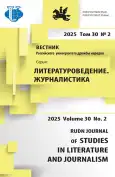«Третьи смыслы»: к семантике корреляции знаковых элементов в поликодовых текстах
- Авторы: Кемарская И.Н.1
-
Учреждения:
- Академия медиаиндустрии
- Выпуск: Том 30, № 2 (2025)
- Страницы: 346-360
- Раздел: Журналистика
- URL: https://journal-vniispk.ru/2312-9220/article/view/319133
- DOI: https://doi.org/10.22363/2312-9220-2025-30-2-346-360
- EDN: https://elibrary.ru/JVPZTQ
- ID: 319133
Цитировать
Полный текст
Аннотация
Актуальность темы определяется растущим интересом научного сообщества к проблемам полисемиотического воздействия медиатекстов. Цель работы - переосмысление концепции структуризации аудиовизуального текста Умберто Эко (1970-е гг.) применительно к современным, радикально изменившимся технологиям. Автор сосредоточен на семиотико-риторической интерпретации инструментов Эко, а также на его вокабулярии, конкретизации ряда параметров, связанных с потенциальным распределением смыслов по регистрам поликодового медийного текста. Исследование базируется на методологии прикладной семиотики, позволяющей анализировать отдельные культурные феномены, например телепередачи, элиминируя непосредственное содержание выпусков, при сохранении общих принципов системности, целостности и комплексности. Определяются проблемные зоны медиакоммуникации и механизмы зрительской семантической корреляции слов и образов, открывающие дополнительные смыслы. Рассматриваются знаковые элементы кодовой и безкодовой природы, механизмы их восприятия реципиентами медиасообщения. Сопряжение визуальных и вербальных фрагментов последовательно закладывается на этапе авторского создания медиасообщения, используются принципы иллюстративности и (или) парадоксальности потенциального воздействия на зрителя, делается вывод о холистической природе восприятия медиасообщения аудиторией, не разделяющей поликодовый текст на автономные составляющие. Проводится разделение воспринимаемых смыслов на явные (проясненные) и неожиданные (непрог оворенные), возникающие из трансформаций положения слова относительно изобра жения.
Ключевые слова
Об авторах
Ирина Николаевна Кемарская
Академия медиаиндустрии
Автор, ответственный за переписку.
Email: kemarskaya2011@yandex.ru
ORCID iD: 0000-0001-7593-8042
SPIN-код: 7827-5046
доктор филологических наук, ведущий научный сотрудник научно-исследовательского сектора
Российская Федерация, 127521, Москва, ул. Октябрьская, д. 105, корп. 2Список литературы
- Bahtin, M.M. (1979). Aesthetics of Verbal Creativity. Мoscow: Iskusstvo Publ. (In Russ.)
- Barthes, R. (2015). The Third Sense. Мoscow: Ad Marginem Press. (In Russ.)
- Berezhnaia, M.A. (2016). Dominants of Audiovisual Text in the Aspect of TV Discourses Research. Vestnik SPbSU. Series 9. Philology. Asian Studies. Journalism, 3, 147–156. (In Russ.) https://doi.org/10.21638/11701/spbu09.2016.317
- Eco, U. (2023). About Television: Articles and Essays 1956–2015. Мoscow: AST; Corpus Publ. (In Russ.)
- Eco, U. (1972). Towards a Semiotic Inquiry into the Television Message. Working Papers in Cultural Studies, (2), 103–121.
- Eisenstein, S.M. (2016). Behind the Scenes. Key Works on Cinema Theory. Moscow: Academic Project; Gaudeamus Publ. (In Russ.)
- Ekman, P. (2013). Emotions Revealed. Psychology of Emotions. I know What You Feel. Moscow: Piter Publ. (In Russ.)
- Gajmakova, B.D., Makarova, S.K., Novikova, V.I., & Ossovskaya, M.P. (2004). Mastery of On-air Performance. Study Guide. Мoscow: Aspect Press. (In Russ.)
- Gambier, Y. (2020). Change and Continuity in Translation. Renewing Communication in a Globalised World. Studies about Languages, 37, 5–19. http://dx.doi.org/10.5755/j01.sal.1.37.27760
- Gunning, T. (2006). Attractions: How They Came into the World. In W. Strauven (Ed.), The Cinema of Attractions Reloaded (pp. 31–41). Amsterdam University Press.
- Kaneman, D. (2014). Thinking, Fast and Slow. Мoscow: AST Publ. (In Russ.)
- Kozulyaev, A.V. (2017). Fundamentals of Innovative Methodology of Formation of Professional Competences of Audiovisual Interpreter. Innovative Projects and Programmes in Education, (6), 55–62. (In Russ.)
- Lotman, Yu., & Tsivyan, Yu. (1994). Dialogue with the Screen. Tallin: Alexandra Publ. (In Russ.)
- Maksimov, V.I. (2021). The Theoretical Basis of the Modern Dance. Bulletin of the Vaganova Ballet Academy, (6), 45–55. (In Russ.)
- Manovich, L. (2007). Understanding Hybrid Media. In Betti-Sue Hertz (Ed.), Animated Paintings (pp. 1–18). San Diego Museum of Art Publ.
- Mansfield, J. (1992). Narration and Editing: Sound for Television. BBC Television Training Publ.
- Mikhalkovich, V.I. (1996). Essay on the Theory of Television. Мoscow: State Institute for Art Studies Publ. (In Russ.)
- Mikhalkovich, V.I. (1998). On the Essence of Television. Мoscow: IPK Publ. (In Russ.)
- Muratov, S.A. (2009). Television in Search of Television. Chronicle of Author’s Observations. Мoscow State University Publ. (In Russ.)
- Ousmanova, A. (2019). The Poetics of the Unspeakable and ‘Le Filmique’ in the Works of Roland Barthes. Topos. Journal for Philosophy and Cultural Studies, (1–2), 150–176. (In Russ.) https://doi.org/10.24412/1815-0047-2019-1-2-150-176
- Pronin, A.A. (2017). Mass-doc: Presumption of Narrativity. Saint Petersburg: Petropolis Publ. (In Russ.)
- Sergeeva, Yu.M., & Uvarova, E.A. (2014). Polycode Text: Peculiarities of Structure and Perception. Science and School, (4), 128–134. (In Russ.)
- Smith, A.N. (2018). Storytelling Industries. Narrative Production in the 21st Century. Palgrave Macmillan Cham.
- Urtmintseva, M.G., & Skachkova, V.N. (2022). Voice-Over Text in Documentary Film Discourse. Nauchnyi dialog, 11(6), 334–349. (In Russ.) https://doi.org/10.24224/2227-1295-2022-11-6-334-349
- Volkova, I.I. (2018). The Streaming Phenomenon: Journalism of the Future? In V.P. Vorobyov (Ed.), Multimedia journalism: collection of scientific papers of the International Scientific and Practical Conference (pp. 213–218). Minsk: BSU Publ. (In Russ.)
- Weissmann, E. (2019). Book Review: Storytelling Industries. Narrative Production in the 21st Century. Critical Studies in Television, Manchester University Press, 14(1), 146–149. https://doi.org/10.1177/1749602018818288c
Дополнительные файлы









